Comparative Financial Analysis of Global Firms: A Detailed Report
VerifiedAdded on 2023/06/12
|38
|10006
|342
Report
AI Summary
This report presents a detailed financial analysis of several global companies, including United Health Group, GSK Group, Reliance Industries, Boehringer Ingelheim, and Kyowa Kirin, with a focus on their commercial and financial characteristics. The analysis covers key aspects such as size (sales, net assets, profits), main markets (geographic and line of business), sources of finance (debt/equity ratio), and nature of group structures. The report also examines the regulations governing published information for listed companies in different countries, highlighting the influence of IFRS and the size and structure of their annual reports. Furthermore, it assesses the use of graphs, charts, and accounting ratios in narrative reporting, as well as the content of highlighted information. The study reveals variations in financial performance, reporting practices, and regulatory compliance across these international firms.
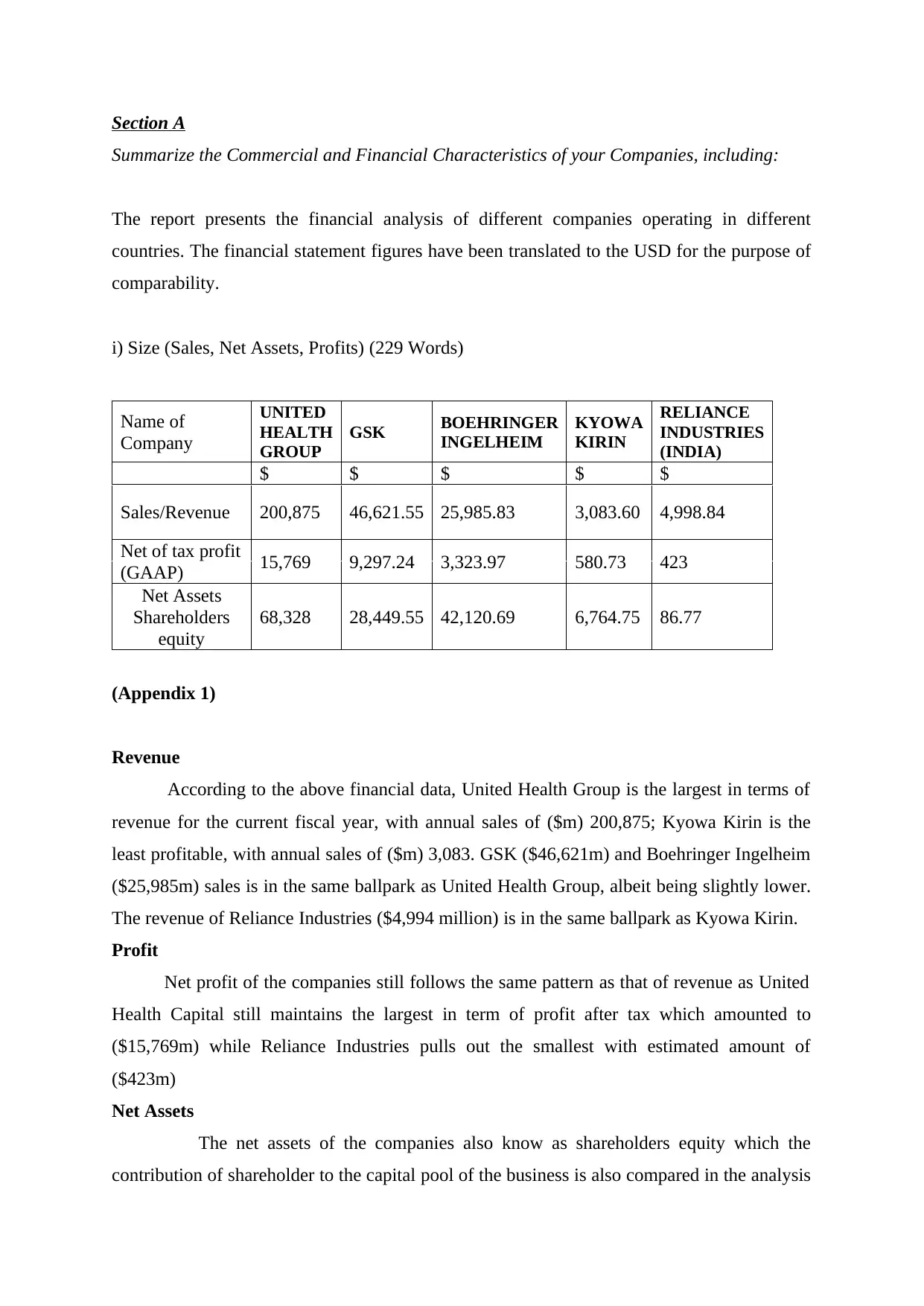
Section A
Summarize the Commercial and Financial Characteristics of your Companies, including:
The report presents the financial analysis of different companies operating in different
countries. The financial statement figures have been translated to the USD for the purpose of
comparability.
i) Size (Sales, Net Assets, Profits) (229 Words)
Name of
Company
UNITED
HEALTH
GROUP
GSK BOEHRINGER
INGELHEIM
KYOWA
KIRIN
RELIANCE
INDUSTRIES
(INDIA)
$ $ $ $ $
Sales/Revenue 200,875 46,621.55 25,985.83 3,083.60 4,998.84
Net of tax profit
(GAAP) 15,769 9,297.24 3,323.97 580.73 423
Net Assets
Shareholders
equity
68,328 28,449.55 42,120.69 6,764.75 86.77
(Appendix 1)
Revenue
According to the above financial data, United Health Group is the largest in terms of
revenue for the current fiscal year, with annual sales of ($m) 200,875; Kyowa Kirin is the
least profitable, with annual sales of ($m) 3,083. GSK ($46,621m) and Boehringer Ingelheim
($25,985m) sales is in the same ballpark as United Health Group, albeit being slightly lower.
The revenue of Reliance Industries ($4,994 million) is in the same ballpark as Kyowa Kirin.
Profit
Net profit of the companies still follows the same pattern as that of revenue as United
Health Capital still maintains the largest in term of profit after tax which amounted to
($15,769m) while Reliance Industries pulls out the smallest with estimated amount of
($423m)
Net Assets
The net assets of the companies also know as shareholders equity which the
contribution of shareholder to the capital pool of the business is also compared in the analysis
Summarize the Commercial and Financial Characteristics of your Companies, including:
The report presents the financial analysis of different companies operating in different
countries. The financial statement figures have been translated to the USD for the purpose of
comparability.
i) Size (Sales, Net Assets, Profits) (229 Words)
Name of
Company
UNITED
HEALTH
GROUP
GSK BOEHRINGER
INGELHEIM
KYOWA
KIRIN
RELIANCE
INDUSTRIES
(INDIA)
$ $ $ $ $
Sales/Revenue 200,875 46,621.55 25,985.83 3,083.60 4,998.84
Net of tax profit
(GAAP) 15,769 9,297.24 3,323.97 580.73 423
Net Assets
Shareholders
equity
68,328 28,449.55 42,120.69 6,764.75 86.77
(Appendix 1)
Revenue
According to the above financial data, United Health Group is the largest in terms of
revenue for the current fiscal year, with annual sales of ($m) 200,875; Kyowa Kirin is the
least profitable, with annual sales of ($m) 3,083. GSK ($46,621m) and Boehringer Ingelheim
($25,985m) sales is in the same ballpark as United Health Group, albeit being slightly lower.
The revenue of Reliance Industries ($4,994 million) is in the same ballpark as Kyowa Kirin.
Profit
Net profit of the companies still follows the same pattern as that of revenue as United
Health Capital still maintains the largest in term of profit after tax which amounted to
($15,769m) while Reliance Industries pulls out the smallest with estimated amount of
($423m)
Net Assets
The net assets of the companies also know as shareholders equity which the
contribution of shareholder to the capital pool of the business is also compared in the analysis
Paraphrase This Document
Need a fresh take? Get an instant paraphrase of this document with our AI Paraphraser
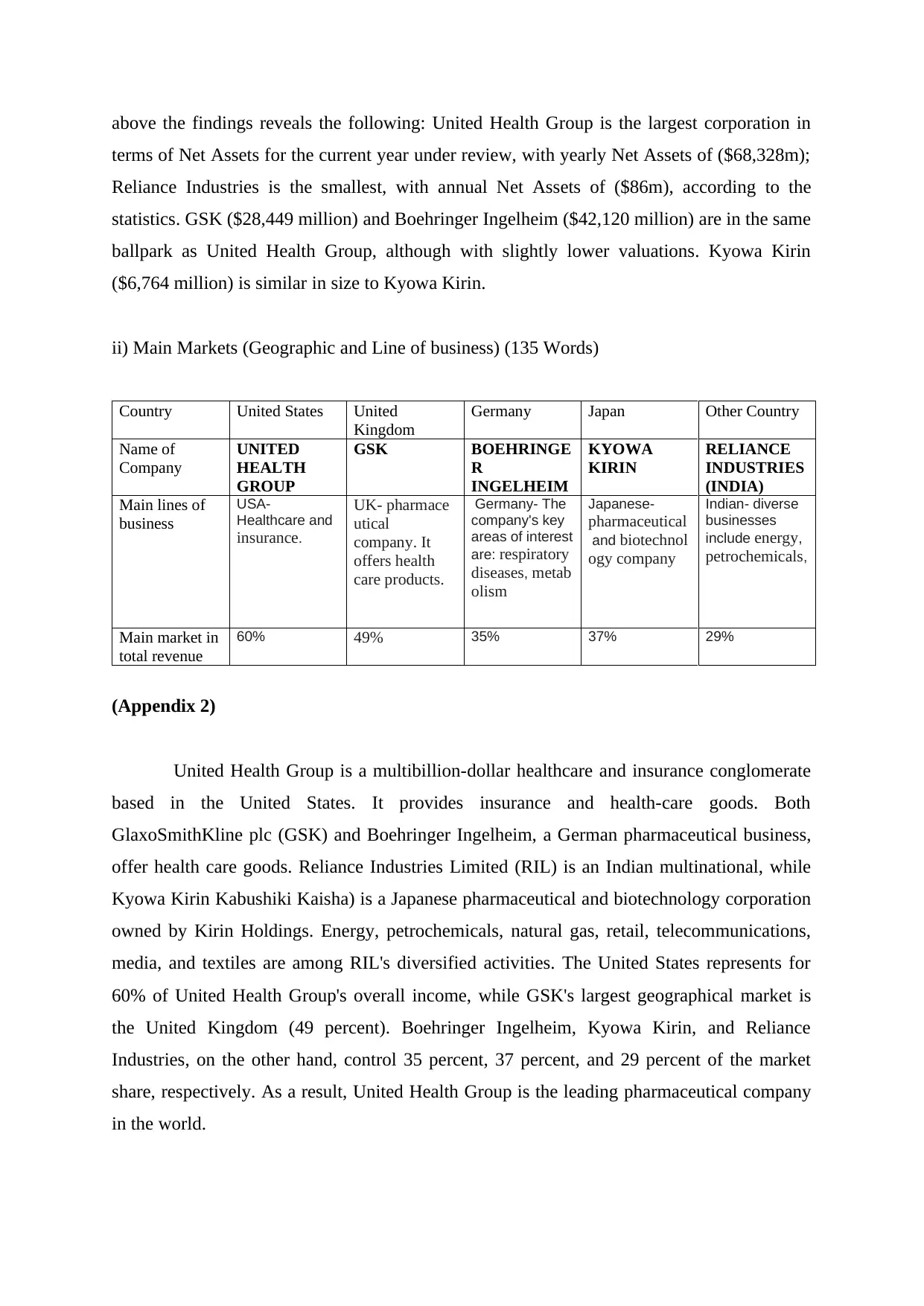
above the findings reveals the following: United Health Group is the largest corporation in
terms of Net Assets for the current year under review, with yearly Net Assets of ($68,328m);
Reliance Industries is the smallest, with annual Net Assets of ($86m), according to the
statistics. GSK ($28,449 million) and Boehringer Ingelheim ($42,120 million) are in the same
ballpark as United Health Group, although with slightly lower valuations. Kyowa Kirin
($6,764 million) is similar in size to Kyowa Kirin.
ii) Main Markets (Geographic and Line of business) (135 Words)
Country United States United
Kingdom
Germany Japan Other Country
Name of
Company
UNITED
HEALTH
GROUP
GSK BOEHRINGE
R
INGELHEIM
KYOWA
KIRIN
RELIANCE
INDUSTRIES
(INDIA)
Main lines of
business
USA-
Healthcare and
insurance.
UK- pharmace
utical
company. It
offers health
care products.
Germany- The
company's key
areas of interest
are: respiratory
diseases, metab
olism
Japanese-
pharmaceutical
and biotechnol
ogy company
Indian- diverse
businesses
include energy,
petrochemicals,
Main market in
total revenue
60% 49% 35% 37% 29%
(Appendix 2)
United Health Group is a multibillion-dollar healthcare and insurance conglomerate
based in the United States. It provides insurance and health-care goods. Both
GlaxoSmithKline plc (GSK) and Boehringer Ingelheim, a German pharmaceutical business,
offer health care goods. Reliance Industries Limited (RIL) is an Indian multinational, while
Kyowa Kirin Kabushiki Kaisha) is a Japanese pharmaceutical and biotechnology corporation
owned by Kirin Holdings. Energy, petrochemicals, natural gas, retail, telecommunications,
media, and textiles are among RIL's diversified activities. The United States represents for
60% of United Health Group's overall income, while GSK's largest geographical market is
the United Kingdom (49 percent). Boehringer Ingelheim, Kyowa Kirin, and Reliance
Industries, on the other hand, control 35 percent, 37 percent, and 29 percent of the market
share, respectively. As a result, United Health Group is the leading pharmaceutical company
in the world.
terms of Net Assets for the current year under review, with yearly Net Assets of ($68,328m);
Reliance Industries is the smallest, with annual Net Assets of ($86m), according to the
statistics. GSK ($28,449 million) and Boehringer Ingelheim ($42,120 million) are in the same
ballpark as United Health Group, although with slightly lower valuations. Kyowa Kirin
($6,764 million) is similar in size to Kyowa Kirin.
ii) Main Markets (Geographic and Line of business) (135 Words)
Country United States United
Kingdom
Germany Japan Other Country
Name of
Company
UNITED
HEALTH
GROUP
GSK BOEHRINGE
R
INGELHEIM
KYOWA
KIRIN
RELIANCE
INDUSTRIES
(INDIA)
Main lines of
business
USA-
Healthcare and
insurance.
UK- pharmace
utical
company. It
offers health
care products.
Germany- The
company's key
areas of interest
are: respiratory
diseases, metab
olism
Japanese-
pharmaceutical
and biotechnol
ogy company
Indian- diverse
businesses
include energy,
petrochemicals,
Main market in
total revenue
60% 49% 35% 37% 29%
(Appendix 2)
United Health Group is a multibillion-dollar healthcare and insurance conglomerate
based in the United States. It provides insurance and health-care goods. Both
GlaxoSmithKline plc (GSK) and Boehringer Ingelheim, a German pharmaceutical business,
offer health care goods. Reliance Industries Limited (RIL) is an Indian multinational, while
Kyowa Kirin Kabushiki Kaisha) is a Japanese pharmaceutical and biotechnology corporation
owned by Kirin Holdings. Energy, petrochemicals, natural gas, retail, telecommunications,
media, and textiles are among RIL's diversified activities. The United States represents for
60% of United Health Group's overall income, while GSK's largest geographical market is
the United Kingdom (49 percent). Boehringer Ingelheim, Kyowa Kirin, and Reliance
Industries, on the other hand, control 35 percent, 37 percent, and 29 percent of the market
share, respectively. As a result, United Health Group is the leading pharmaceutical company
in the world.

iii.) Sources of Finance (116 Words)
Name of Company UNITED
HEALTH
GROUP
GSK BOEHRINGE
R
INGELHEIM
KYOWA
KIRIN
RELIANCE
INDUSTRIE
S (INDIA)
Debt/Equity ratio) =56.6% =112% = 7.44% =2% =7.4%
Nature of Finance The company is
financed by Debt
and Equity
The company
is financed by
Debt and
Equity
The company is
financed by
Debt and Equity
The company
is financed by
Debt and
Equity
The company
is financed by
Debt and
Equity
(Appendix 3)
The sources of finance of any company is referred to as the capital structure; which is the mix
of debt and equity in financial a business. From our analysis, we found out the following:
United Health Group is mainly financed by equity (shareholders contribution) as the
ratio od debt to equity is below 100% which stood at 56.6%
GSK is predominantly financed by debt with percentage of debt to equity is above
100% which stood at 112%.
The ratio in Boehringer Ingelheim, Kyowa Kirin, and Reliance Industries, on the
other hand shows less than 10% debts in the percentage of financing. This means that
the companies are more than 90% financed by equities.
iv) Nature of Group Structures (64 Words)
(Appendix 4)
All the companies have subsidiaries, and we can see from the percentage of equity
accounted for by non-controlling interest below that they all have a tiny percentage, implying
that they control most of their subsidiaries. Joint ventures are used by some firms, such as
Boehringer Ingelheim and Kyowa Kirin, while associate/collaboration is used by others, such
as United Health Group, GSK and Reliance Industries.
Section B
Regulations of Published Information of Listed Companies (278 Words)
Name of Company UNITED
HEALTH
GROUP
GSK BOEHRINGE
R
INGELHEIM
KYOWA
KIRIN
RELIANCE
INDUSTRIE
S (INDIA)
Debt/Equity ratio) =56.6% =112% = 7.44% =2% =7.4%
Nature of Finance The company is
financed by Debt
and Equity
The company
is financed by
Debt and
Equity
The company is
financed by
Debt and Equity
The company
is financed by
Debt and
Equity
The company
is financed by
Debt and
Equity
(Appendix 3)
The sources of finance of any company is referred to as the capital structure; which is the mix
of debt and equity in financial a business. From our analysis, we found out the following:
United Health Group is mainly financed by equity (shareholders contribution) as the
ratio od debt to equity is below 100% which stood at 56.6%
GSK is predominantly financed by debt with percentage of debt to equity is above
100% which stood at 112%.
The ratio in Boehringer Ingelheim, Kyowa Kirin, and Reliance Industries, on the
other hand shows less than 10% debts in the percentage of financing. This means that
the companies are more than 90% financed by equities.
iv) Nature of Group Structures (64 Words)
(Appendix 4)
All the companies have subsidiaries, and we can see from the percentage of equity
accounted for by non-controlling interest below that they all have a tiny percentage, implying
that they control most of their subsidiaries. Joint ventures are used by some firms, such as
Boehringer Ingelheim and Kyowa Kirin, while associate/collaboration is used by others, such
as United Health Group, GSK and Reliance Industries.
Section B
Regulations of Published Information of Listed Companies (278 Words)
⊘ This is a preview!⊘
Do you want full access?
Subscribe today to unlock all pages.

Trusted by 1+ million students worldwide
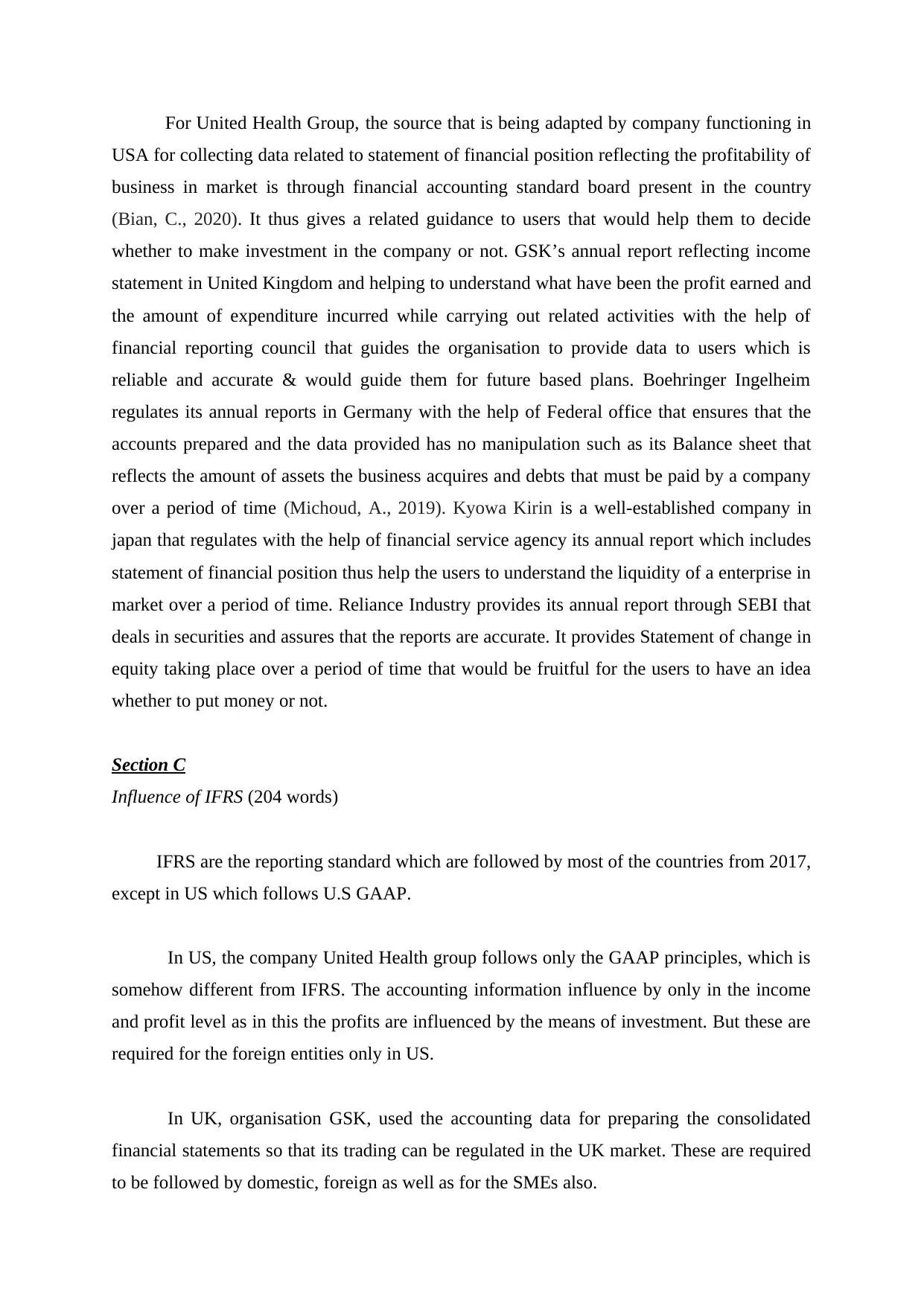
For United Health Group, the source that is being adapted by company functioning in
USA for collecting data related to statement of financial position reflecting the profitability of
business in market is through financial accounting standard board present in the country
(Bian, C., 2020). It thus gives a related guidance to users that would help them to decide
whether to make investment in the company or not. GSK’s annual report reflecting income
statement in United Kingdom and helping to understand what have been the profit earned and
the amount of expenditure incurred while carrying out related activities with the help of
financial reporting council that guides the organisation to provide data to users which is
reliable and accurate & would guide them for future based plans. Boehringer Ingelheim
regulates its annual reports in Germany with the help of Federal office that ensures that the
accounts prepared and the data provided has no manipulation such as its Balance sheet that
reflects the amount of assets the business acquires and debts that must be paid by a company
over a period of time (Michoud, A., 2019). Kyowa Kirin is a well-established company in
japan that regulates with the help of financial service agency its annual report which includes
statement of financial position thus help the users to understand the liquidity of a enterprise in
market over a period of time. Reliance Industry provides its annual report through SEBI that
deals in securities and assures that the reports are accurate. It provides Statement of change in
equity taking place over a period of time that would be fruitful for the users to have an idea
whether to put money or not.
Section C
Influence of IFRS (204 words)
IFRS are the reporting standard which are followed by most of the countries from 2017,
except in US which follows U.S GAAP.
In US, the company United Health group follows only the GAAP principles, which is
somehow different from IFRS. The accounting information influence by only in the income
and profit level as in this the profits are influenced by the means of investment. But these are
required for the foreign entities only in US.
In UK, organisation GSK, used the accounting data for preparing the consolidated
financial statements so that its trading can be regulated in the UK market. These are required
to be followed by domestic, foreign as well as for the SMEs also.
USA for collecting data related to statement of financial position reflecting the profitability of
business in market is through financial accounting standard board present in the country
(Bian, C., 2020). It thus gives a related guidance to users that would help them to decide
whether to make investment in the company or not. GSK’s annual report reflecting income
statement in United Kingdom and helping to understand what have been the profit earned and
the amount of expenditure incurred while carrying out related activities with the help of
financial reporting council that guides the organisation to provide data to users which is
reliable and accurate & would guide them for future based plans. Boehringer Ingelheim
regulates its annual reports in Germany with the help of Federal office that ensures that the
accounts prepared and the data provided has no manipulation such as its Balance sheet that
reflects the amount of assets the business acquires and debts that must be paid by a company
over a period of time (Michoud, A., 2019). Kyowa Kirin is a well-established company in
japan that regulates with the help of financial service agency its annual report which includes
statement of financial position thus help the users to understand the liquidity of a enterprise in
market over a period of time. Reliance Industry provides its annual report through SEBI that
deals in securities and assures that the reports are accurate. It provides Statement of change in
equity taking place over a period of time that would be fruitful for the users to have an idea
whether to put money or not.
Section C
Influence of IFRS (204 words)
IFRS are the reporting standard which are followed by most of the countries from 2017,
except in US which follows U.S GAAP.
In US, the company United Health group follows only the GAAP principles, which is
somehow different from IFRS. The accounting information influence by only in the income
and profit level as in this the profits are influenced by the means of investment. But these are
required for the foreign entities only in US.
In UK, organisation GSK, used the accounting data for preparing the consolidated
financial statements so that its trading can be regulated in the UK market. These are required
to be followed by domestic, foreign as well as for the SMEs also.
Paraphrase This Document
Need a fresh take? Get an instant paraphrase of this document with our AI Paraphraser
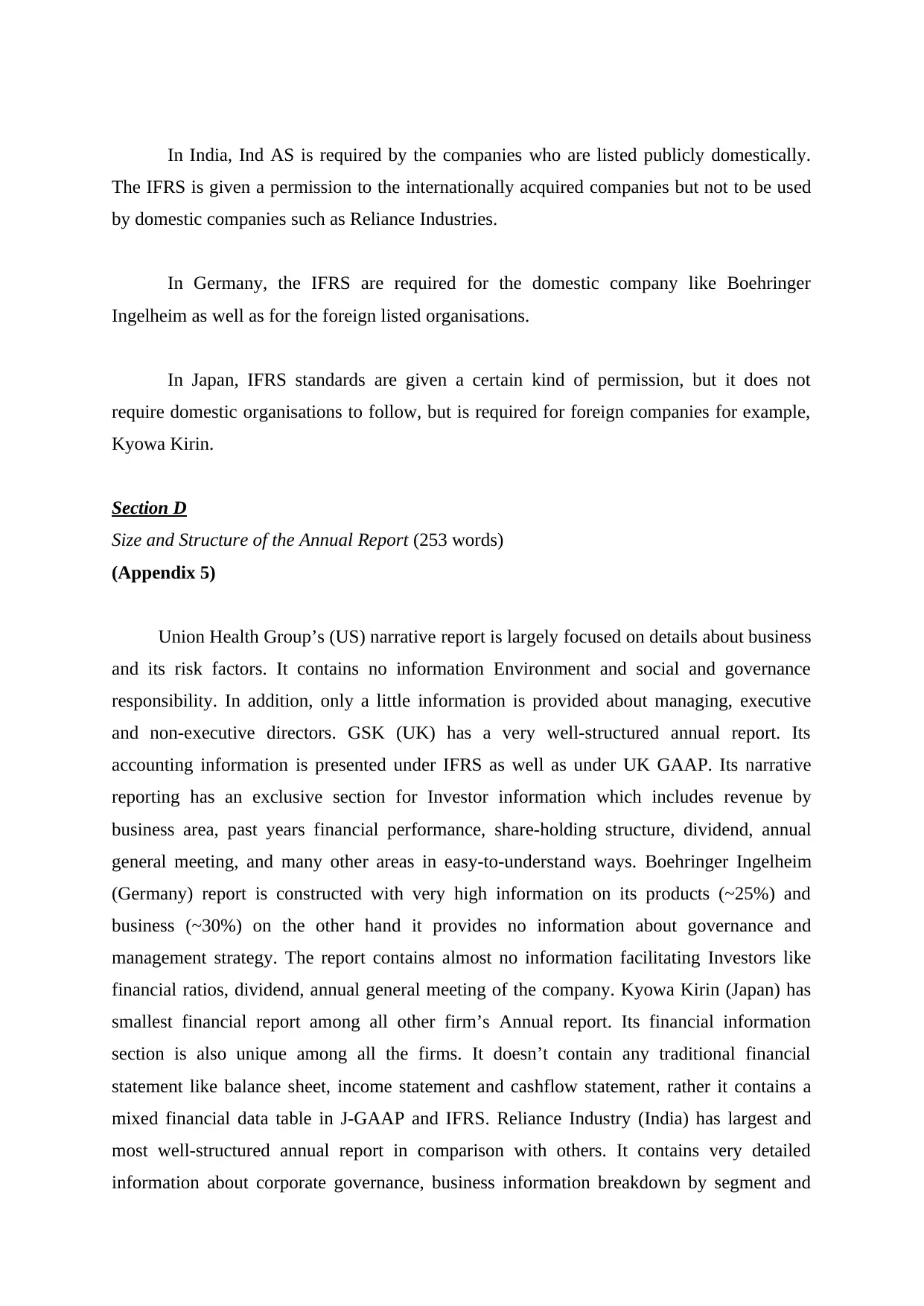
In India, Ind AS is required by the companies who are listed publicly domestically.
The IFRS is given a permission to the internationally acquired companies but not to be used
by domestic companies such as Reliance Industries.
In Germany, the IFRS are required for the domestic company like Boehringer
Ingelheim as well as for the foreign listed organisations.
In Japan, IFRS standards are given a certain kind of permission, but it does not
require domestic organisations to follow, but is required for foreign companies for example,
Kyowa Kirin.
Section D
Size and Structure of the Annual Report (253 words)
(Appendix 5)
Union Health Group’s (US) narrative report is largely focused on details about business
and its risk factors. It contains no information Environment and social and governance
responsibility. In addition, only a little information is provided about managing, executive
and non-executive directors. GSK (UK) has a very well-structured annual report. Its
accounting information is presented under IFRS as well as under UK GAAP. Its narrative
reporting has an exclusive section for Investor information which includes revenue by
business area, past years financial performance, share-holding structure, dividend, annual
general meeting, and many other areas in easy-to-understand ways. Boehringer Ingelheim
(Germany) report is constructed with very high information on its products (~25%) and
business (~30%) on the other hand it provides no information about governance and
management strategy. The report contains almost no information facilitating Investors like
financial ratios, dividend, annual general meeting of the company. Kyowa Kirin (Japan) has
smallest financial report among all other firm’s Annual report. Its financial information
section is also unique among all the firms. It doesn’t contain any traditional financial
statement like balance sheet, income statement and cashflow statement, rather it contains a
mixed financial data table in J-GAAP and IFRS. Reliance Industry (India) has largest and
most well-structured annual report in comparison with others. It contains very detailed
information about corporate governance, business information breakdown by segment and
The IFRS is given a permission to the internationally acquired companies but not to be used
by domestic companies such as Reliance Industries.
In Germany, the IFRS are required for the domestic company like Boehringer
Ingelheim as well as for the foreign listed organisations.
In Japan, IFRS standards are given a certain kind of permission, but it does not
require domestic organisations to follow, but is required for foreign companies for example,
Kyowa Kirin.
Section D
Size and Structure of the Annual Report (253 words)
(Appendix 5)
Union Health Group’s (US) narrative report is largely focused on details about business
and its risk factors. It contains no information Environment and social and governance
responsibility. In addition, only a little information is provided about managing, executive
and non-executive directors. GSK (UK) has a very well-structured annual report. Its
accounting information is presented under IFRS as well as under UK GAAP. Its narrative
reporting has an exclusive section for Investor information which includes revenue by
business area, past years financial performance, share-holding structure, dividend, annual
general meeting, and many other areas in easy-to-understand ways. Boehringer Ingelheim
(Germany) report is constructed with very high information on its products (~25%) and
business (~30%) on the other hand it provides no information about governance and
management strategy. The report contains almost no information facilitating Investors like
financial ratios, dividend, annual general meeting of the company. Kyowa Kirin (Japan) has
smallest financial report among all other firm’s Annual report. Its financial information
section is also unique among all the firms. It doesn’t contain any traditional financial
statement like balance sheet, income statement and cashflow statement, rather it contains a
mixed financial data table in J-GAAP and IFRS. Reliance Industry (India) has largest and
most well-structured annual report in comparison with others. It contains very detailed
information about corporate governance, business information breakdown by segment and
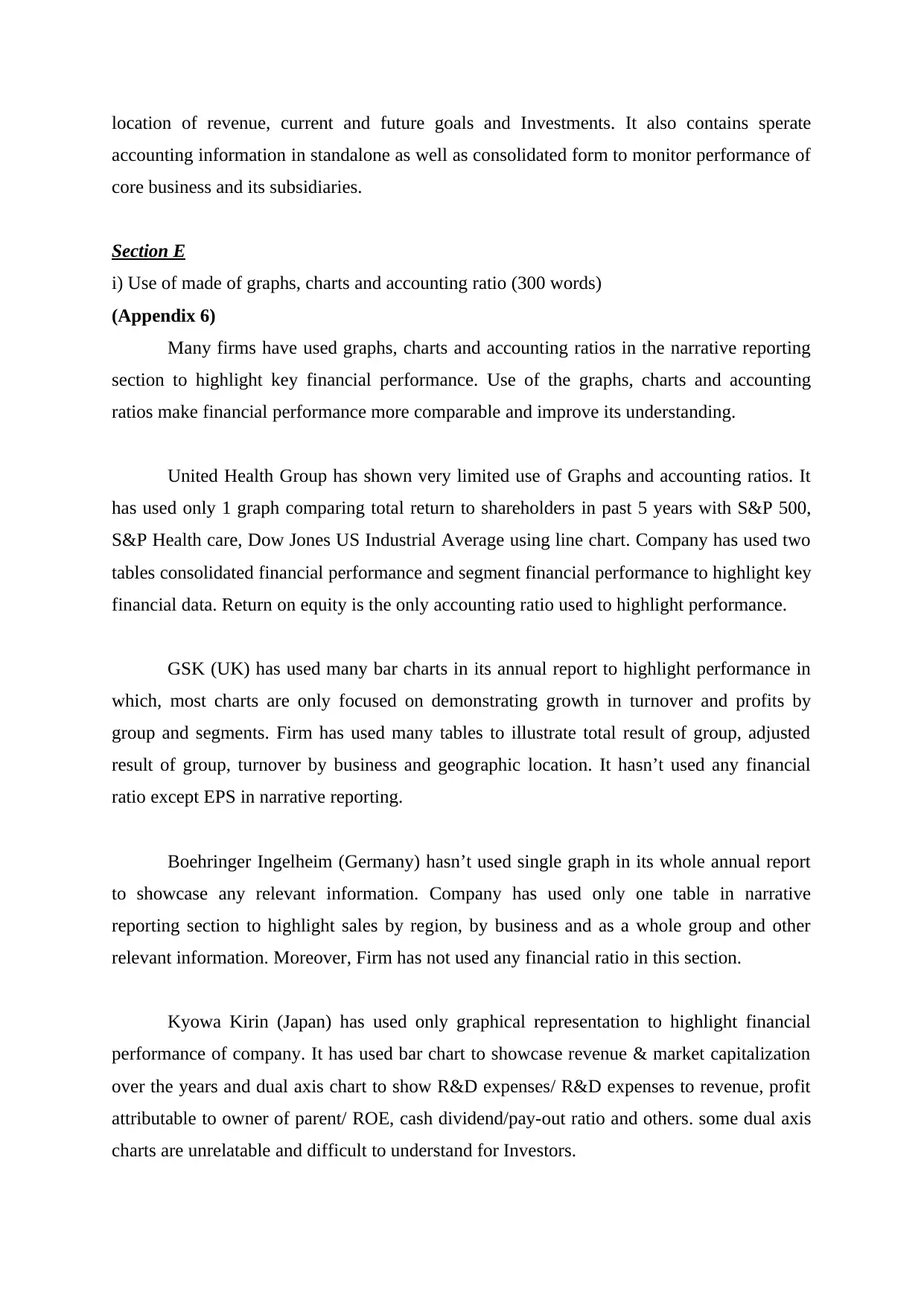
location of revenue, current and future goals and Investments. It also contains sperate
accounting information in standalone as well as consolidated form to monitor performance of
core business and its subsidiaries.
Section E
i) Use of made of graphs, charts and accounting ratio (300 words)
(Appendix 6)
Many firms have used graphs, charts and accounting ratios in the narrative reporting
section to highlight key financial performance. Use of the graphs, charts and accounting
ratios make financial performance more comparable and improve its understanding.
United Health Group has shown very limited use of Graphs and accounting ratios. It
has used only 1 graph comparing total return to shareholders in past 5 years with S&P 500,
S&P Health care, Dow Jones US Industrial Average using line chart. Company has used two
tables consolidated financial performance and segment financial performance to highlight key
financial data. Return on equity is the only accounting ratio used to highlight performance.
GSK (UK) has used many bar charts in its annual report to highlight performance in
which, most charts are only focused on demonstrating growth in turnover and profits by
group and segments. Firm has used many tables to illustrate total result of group, adjusted
result of group, turnover by business and geographic location. It hasn’t used any financial
ratio except EPS in narrative reporting.
Boehringer Ingelheim (Germany) hasn’t used single graph in its whole annual report
to showcase any relevant information. Company has used only one table in narrative
reporting section to highlight sales by region, by business and as a whole group and other
relevant information. Moreover, Firm has not used any financial ratio in this section.
Kyowa Kirin (Japan) has used only graphical representation to highlight financial
performance of company. It has used bar chart to showcase revenue & market capitalization
over the years and dual axis chart to show R&D expenses/ R&D expenses to revenue, profit
attributable to owner of parent/ ROE, cash dividend/pay-out ratio and others. some dual axis
charts are unrelatable and difficult to understand for Investors.
accounting information in standalone as well as consolidated form to monitor performance of
core business and its subsidiaries.
Section E
i) Use of made of graphs, charts and accounting ratio (300 words)
(Appendix 6)
Many firms have used graphs, charts and accounting ratios in the narrative reporting
section to highlight key financial performance. Use of the graphs, charts and accounting
ratios make financial performance more comparable and improve its understanding.
United Health Group has shown very limited use of Graphs and accounting ratios. It
has used only 1 graph comparing total return to shareholders in past 5 years with S&P 500,
S&P Health care, Dow Jones US Industrial Average using line chart. Company has used two
tables consolidated financial performance and segment financial performance to highlight key
financial data. Return on equity is the only accounting ratio used to highlight performance.
GSK (UK) has used many bar charts in its annual report to highlight performance in
which, most charts are only focused on demonstrating growth in turnover and profits by
group and segments. Firm has used many tables to illustrate total result of group, adjusted
result of group, turnover by business and geographic location. It hasn’t used any financial
ratio except EPS in narrative reporting.
Boehringer Ingelheim (Germany) hasn’t used single graph in its whole annual report
to showcase any relevant information. Company has used only one table in narrative
reporting section to highlight sales by region, by business and as a whole group and other
relevant information. Moreover, Firm has not used any financial ratio in this section.
Kyowa Kirin (Japan) has used only graphical representation to highlight financial
performance of company. It has used bar chart to showcase revenue & market capitalization
over the years and dual axis chart to show R&D expenses/ R&D expenses to revenue, profit
attributable to owner of parent/ ROE, cash dividend/pay-out ratio and others. some dual axis
charts are unrelatable and difficult to understand for Investors.
⊘ This is a preview!⊘
Do you want full access?
Subscribe today to unlock all pages.

Trusted by 1+ million students worldwide
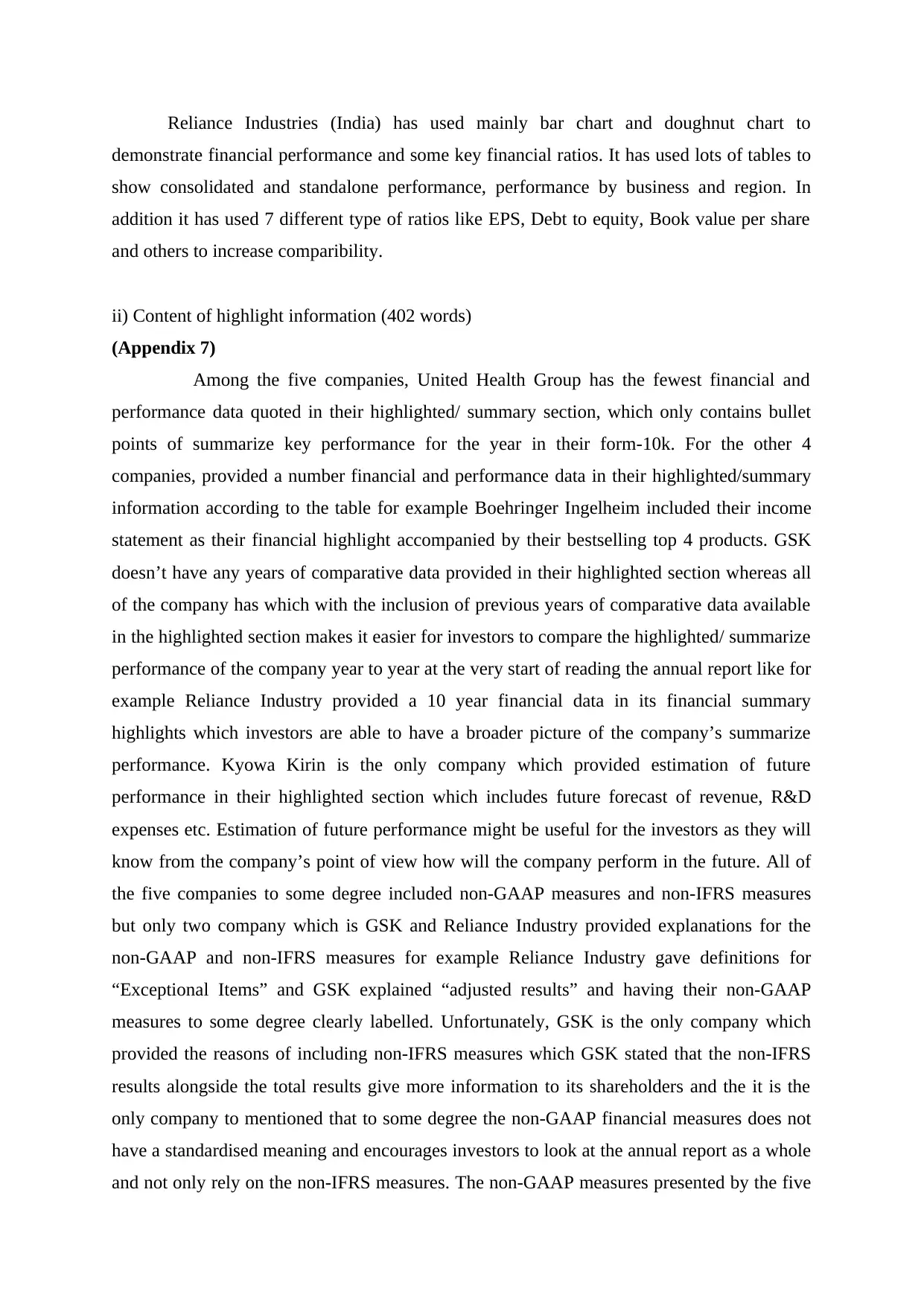
Reliance Industries (India) has used mainly bar chart and doughnut chart to
demonstrate financial performance and some key financial ratios. It has used lots of tables to
show consolidated and standalone performance, performance by business and region. In
addition it has used 7 different type of ratios like EPS, Debt to equity, Book value per share
and others to increase comparibility.
ii) Content of highlight information (402 words)
(Appendix 7)
Among the five companies, United Health Group has the fewest financial and
performance data quoted in their highlighted/ summary section, which only contains bullet
points of summarize key performance for the year in their form-10k. For the other 4
companies, provided a number financial and performance data in their highlighted/summary
information according to the table for example Boehringer Ingelheim included their income
statement as their financial highlight accompanied by their bestselling top 4 products. GSK
doesn’t have any years of comparative data provided in their highlighted section whereas all
of the company has which with the inclusion of previous years of comparative data available
in the highlighted section makes it easier for investors to compare the highlighted/ summarize
performance of the company year to year at the very start of reading the annual report like for
example Reliance Industry provided a 10 year financial data in its financial summary
highlights which investors are able to have a broader picture of the company’s summarize
performance. Kyowa Kirin is the only company which provided estimation of future
performance in their highlighted section which includes future forecast of revenue, R&D
expenses etc. Estimation of future performance might be useful for the investors as they will
know from the company’s point of view how will the company perform in the future. All of
the five companies to some degree included non-GAAP measures and non-IFRS measures
but only two company which is GSK and Reliance Industry provided explanations for the
non-GAAP and non-IFRS measures for example Reliance Industry gave definitions for
“Exceptional Items” and GSK explained “adjusted results” and having their non-GAAP
measures to some degree clearly labelled. Unfortunately, GSK is the only company which
provided the reasons of including non-IFRS measures which GSK stated that the non-IFRS
results alongside the total results give more information to its shareholders and the it is the
only company to mentioned that to some degree the non-GAAP financial measures does not
have a standardised meaning and encourages investors to look at the annual report as a whole
and not only rely on the non-IFRS measures. The non-GAAP measures presented by the five
demonstrate financial performance and some key financial ratios. It has used lots of tables to
show consolidated and standalone performance, performance by business and region. In
addition it has used 7 different type of ratios like EPS, Debt to equity, Book value per share
and others to increase comparibility.
ii) Content of highlight information (402 words)
(Appendix 7)
Among the five companies, United Health Group has the fewest financial and
performance data quoted in their highlighted/ summary section, which only contains bullet
points of summarize key performance for the year in their form-10k. For the other 4
companies, provided a number financial and performance data in their highlighted/summary
information according to the table for example Boehringer Ingelheim included their income
statement as their financial highlight accompanied by their bestselling top 4 products. GSK
doesn’t have any years of comparative data provided in their highlighted section whereas all
of the company has which with the inclusion of previous years of comparative data available
in the highlighted section makes it easier for investors to compare the highlighted/ summarize
performance of the company year to year at the very start of reading the annual report like for
example Reliance Industry provided a 10 year financial data in its financial summary
highlights which investors are able to have a broader picture of the company’s summarize
performance. Kyowa Kirin is the only company which provided estimation of future
performance in their highlighted section which includes future forecast of revenue, R&D
expenses etc. Estimation of future performance might be useful for the investors as they will
know from the company’s point of view how will the company perform in the future. All of
the five companies to some degree included non-GAAP measures and non-IFRS measures
but only two company which is GSK and Reliance Industry provided explanations for the
non-GAAP and non-IFRS measures for example Reliance Industry gave definitions for
“Exceptional Items” and GSK explained “adjusted results” and having their non-GAAP
measures to some degree clearly labelled. Unfortunately, GSK is the only company which
provided the reasons of including non-IFRS measures which GSK stated that the non-IFRS
results alongside the total results give more information to its shareholders and the it is the
only company to mentioned that to some degree the non-GAAP financial measures does not
have a standardised meaning and encourages investors to look at the annual report as a whole
and not only rely on the non-IFRS measures. The non-GAAP measures presented by the five
Paraphrase This Document
Need a fresh take? Get an instant paraphrase of this document with our AI Paraphraser
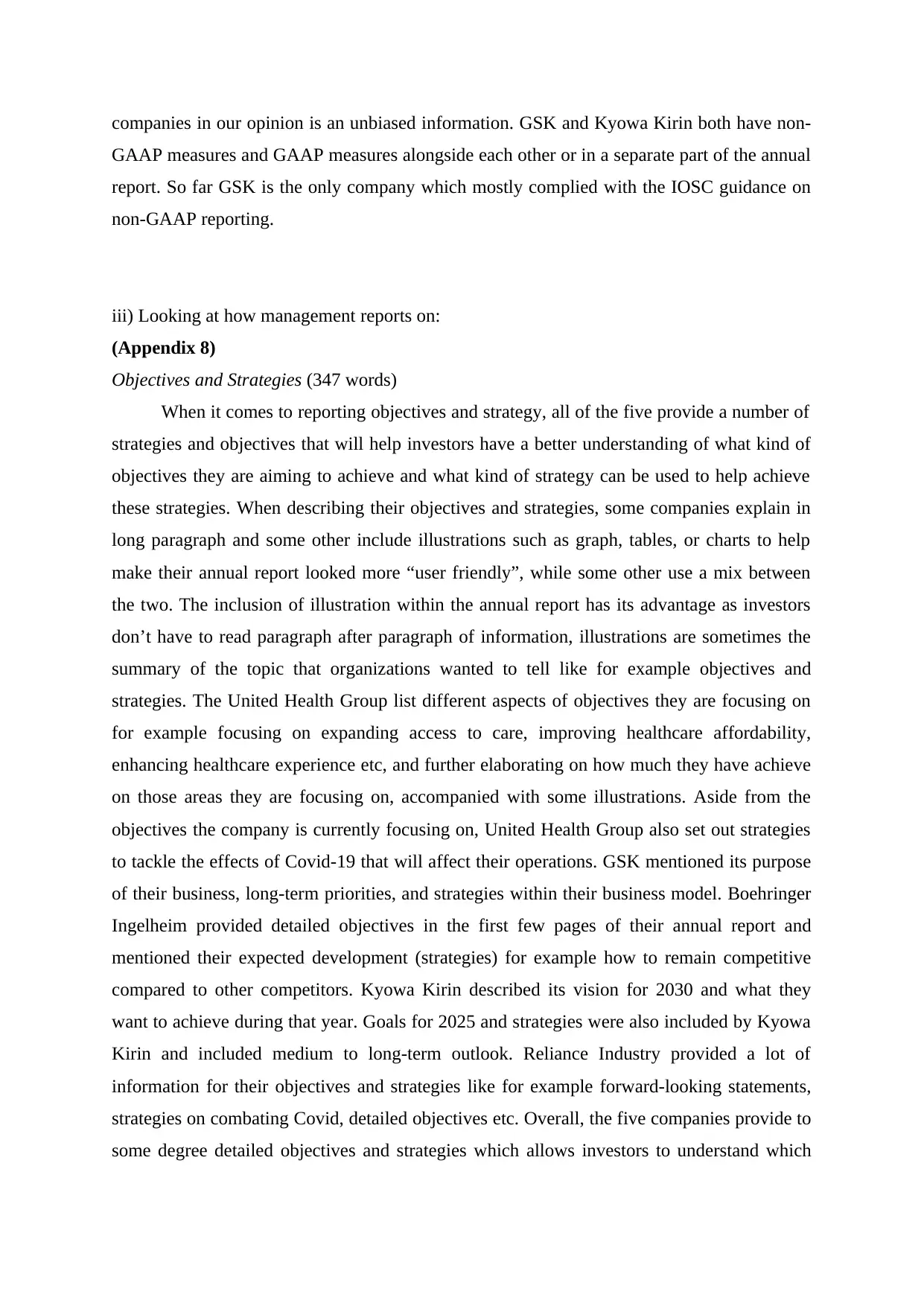
companies in our opinion is an unbiased information. GSK and Kyowa Kirin both have non-
GAAP measures and GAAP measures alongside each other or in a separate part of the annual
report. So far GSK is the only company which mostly complied with the IOSC guidance on
non-GAAP reporting.
iii) Looking at how management reports on:
(Appendix 8)
Objectives and Strategies (347 words)
When it comes to reporting objectives and strategy, all of the five provide a number of
strategies and objectives that will help investors have a better understanding of what kind of
objectives they are aiming to achieve and what kind of strategy can be used to help achieve
these strategies. When describing their objectives and strategies, some companies explain in
long paragraph and some other include illustrations such as graph, tables, or charts to help
make their annual report looked more “user friendly”, while some other use a mix between
the two. The inclusion of illustration within the annual report has its advantage as investors
don’t have to read paragraph after paragraph of information, illustrations are sometimes the
summary of the topic that organizations wanted to tell like for example objectives and
strategies. The United Health Group list different aspects of objectives they are focusing on
for example focusing on expanding access to care, improving healthcare affordability,
enhancing healthcare experience etc, and further elaborating on how much they have achieve
on those areas they are focusing on, accompanied with some illustrations. Aside from the
objectives the company is currently focusing on, United Health Group also set out strategies
to tackle the effects of Covid-19 that will affect their operations. GSK mentioned its purpose
of their business, long-term priorities, and strategies within their business model. Boehringer
Ingelheim provided detailed objectives in the first few pages of their annual report and
mentioned their expected development (strategies) for example how to remain competitive
compared to other competitors. Kyowa Kirin described its vision for 2030 and what they
want to achieve during that year. Goals for 2025 and strategies were also included by Kyowa
Kirin and included medium to long-term outlook. Reliance Industry provided a lot of
information for their objectives and strategies like for example forward-looking statements,
strategies on combating Covid, detailed objectives etc. Overall, the five companies provide to
some degree detailed objectives and strategies which allows investors to understand which
GAAP measures and GAAP measures alongside each other or in a separate part of the annual
report. So far GSK is the only company which mostly complied with the IOSC guidance on
non-GAAP reporting.
iii) Looking at how management reports on:
(Appendix 8)
Objectives and Strategies (347 words)
When it comes to reporting objectives and strategy, all of the five provide a number of
strategies and objectives that will help investors have a better understanding of what kind of
objectives they are aiming to achieve and what kind of strategy can be used to help achieve
these strategies. When describing their objectives and strategies, some companies explain in
long paragraph and some other include illustrations such as graph, tables, or charts to help
make their annual report looked more “user friendly”, while some other use a mix between
the two. The inclusion of illustration within the annual report has its advantage as investors
don’t have to read paragraph after paragraph of information, illustrations are sometimes the
summary of the topic that organizations wanted to tell like for example objectives and
strategies. The United Health Group list different aspects of objectives they are focusing on
for example focusing on expanding access to care, improving healthcare affordability,
enhancing healthcare experience etc, and further elaborating on how much they have achieve
on those areas they are focusing on, accompanied with some illustrations. Aside from the
objectives the company is currently focusing on, United Health Group also set out strategies
to tackle the effects of Covid-19 that will affect their operations. GSK mentioned its purpose
of their business, long-term priorities, and strategies within their business model. Boehringer
Ingelheim provided detailed objectives in the first few pages of their annual report and
mentioned their expected development (strategies) for example how to remain competitive
compared to other competitors. Kyowa Kirin described its vision for 2030 and what they
want to achieve during that year. Goals for 2025 and strategies were also included by Kyowa
Kirin and included medium to long-term outlook. Reliance Industry provided a lot of
information for their objectives and strategies like for example forward-looking statements,
strategies on combating Covid, detailed objectives etc. Overall, the five companies provide to
some degree detailed objectives and strategies which allows investors to understand which

direction the companies are heading to and what kind of methods they will use to achieve
those paths.
Resource, Risk and Relationships (139 words)
When it comes to the risks, the five companies did provide detailed explanations of the
risk and uncertainties that the companies currently facing and any future uncertainties, and
some company provided explanations of responses to the risk. Including risk and
uncertainties in the report allows investors to know what kind of risk that the company is
currently facing and what kind of future risk will affect the company, knowing all these
investors are able to decide based on the risk is it worth to invest in the company or not. A
good example will be United Health Group which they provide information regarding its
enterprise-wide risk, cyber risk, Covid-19 risk, regulatory uncertainties etc. Reliance Industry
is the only company which provided solutions and strategies to combat and avoid the risk
which is a useful addition in the annual report.
Results and Prospects (136 words)
Within the five companies, only United Health Group didn’t provide any elaboration of
results and prospects while the other has included it. The elaboration of results and prospects
within the annual report provides elaboration on what the organization during the year has
achieved and what kind of prospects the company had visioned, this provides further
information to investors as the achievements of the company to some degree influence the
investment decisions of investors. Most of the four companies provided detailed and
elaborated information regarding its results and achievements for example Kyowa Kirin
included its performance and results of its domestic and overseas operations, giving investors
the details on how its operations are doing. Reliance industry also provided prospects plans
and objectives which allow investors to understand what’s the next step Reliance Industry
will be heading to.
Performance Measures and Indicators (201 words)
When it comes to the performance measures and indicators, companies usually report
on the performance of the organization financially (Sales of specific products, remuneration
etc) or non-financial performance (Production speed, ESG etc). All of the five companies to
some degree provided information regarding their financial and non-financial performance so
that besides getting to know the financial performance of the company, investors are able to
those paths.
Resource, Risk and Relationships (139 words)
When it comes to the risks, the five companies did provide detailed explanations of the
risk and uncertainties that the companies currently facing and any future uncertainties, and
some company provided explanations of responses to the risk. Including risk and
uncertainties in the report allows investors to know what kind of risk that the company is
currently facing and what kind of future risk will affect the company, knowing all these
investors are able to decide based on the risk is it worth to invest in the company or not. A
good example will be United Health Group which they provide information regarding its
enterprise-wide risk, cyber risk, Covid-19 risk, regulatory uncertainties etc. Reliance Industry
is the only company which provided solutions and strategies to combat and avoid the risk
which is a useful addition in the annual report.
Results and Prospects (136 words)
Within the five companies, only United Health Group didn’t provide any elaboration of
results and prospects while the other has included it. The elaboration of results and prospects
within the annual report provides elaboration on what the organization during the year has
achieved and what kind of prospects the company had visioned, this provides further
information to investors as the achievements of the company to some degree influence the
investment decisions of investors. Most of the four companies provided detailed and
elaborated information regarding its results and achievements for example Kyowa Kirin
included its performance and results of its domestic and overseas operations, giving investors
the details on how its operations are doing. Reliance industry also provided prospects plans
and objectives which allow investors to understand what’s the next step Reliance Industry
will be heading to.
Performance Measures and Indicators (201 words)
When it comes to the performance measures and indicators, companies usually report
on the performance of the organization financially (Sales of specific products, remuneration
etc) or non-financial performance (Production speed, ESG etc). All of the five companies to
some degree provided information regarding their financial and non-financial performance so
that besides getting to know the financial performance of the company, investors are able to
⊘ This is a preview!⊘
Do you want full access?
Subscribe today to unlock all pages.

Trusted by 1+ million students worldwide
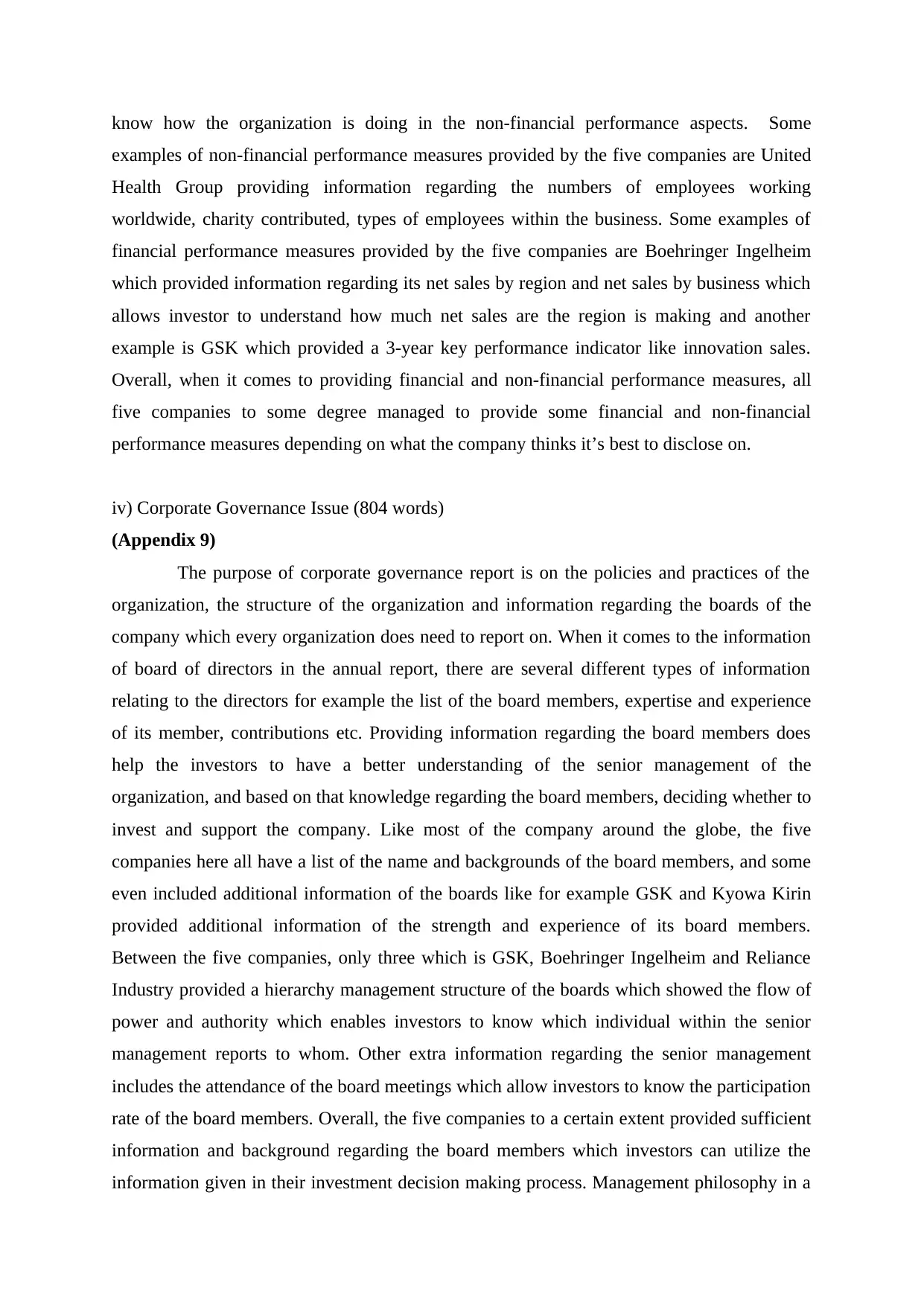
know how the organization is doing in the non-financial performance aspects. Some
examples of non-financial performance measures provided by the five companies are United
Health Group providing information regarding the numbers of employees working
worldwide, charity contributed, types of employees within the business. Some examples of
financial performance measures provided by the five companies are Boehringer Ingelheim
which provided information regarding its net sales by region and net sales by business which
allows investor to understand how much net sales are the region is making and another
example is GSK which provided a 3-year key performance indicator like innovation sales.
Overall, when it comes to providing financial and non-financial performance measures, all
five companies to some degree managed to provide some financial and non-financial
performance measures depending on what the company thinks it’s best to disclose on.
iv) Corporate Governance Issue (804 words)
(Appendix 9)
The purpose of corporate governance report is on the policies and practices of the
organization, the structure of the organization and information regarding the boards of the
company which every organization does need to report on. When it comes to the information
of board of directors in the annual report, there are several different types of information
relating to the directors for example the list of the board members, expertise and experience
of its member, contributions etc. Providing information regarding the board members does
help the investors to have a better understanding of the senior management of the
organization, and based on that knowledge regarding the board members, deciding whether to
invest and support the company. Like most of the company around the globe, the five
companies here all have a list of the name and backgrounds of the board members, and some
even included additional information of the boards like for example GSK and Kyowa Kirin
provided additional information of the strength and experience of its board members.
Between the five companies, only three which is GSK, Boehringer Ingelheim and Reliance
Industry provided a hierarchy management structure of the boards which showed the flow of
power and authority which enables investors to know which individual within the senior
management reports to whom. Other extra information regarding the senior management
includes the attendance of the board meetings which allow investors to know the participation
rate of the board members. Overall, the five companies to a certain extent provided sufficient
information and background regarding the board members which investors can utilize the
information given in their investment decision making process. Management philosophy in a
examples of non-financial performance measures provided by the five companies are United
Health Group providing information regarding the numbers of employees working
worldwide, charity contributed, types of employees within the business. Some examples of
financial performance measures provided by the five companies are Boehringer Ingelheim
which provided information regarding its net sales by region and net sales by business which
allows investor to understand how much net sales are the region is making and another
example is GSK which provided a 3-year key performance indicator like innovation sales.
Overall, when it comes to providing financial and non-financial performance measures, all
five companies to some degree managed to provide some financial and non-financial
performance measures depending on what the company thinks it’s best to disclose on.
iv) Corporate Governance Issue (804 words)
(Appendix 9)
The purpose of corporate governance report is on the policies and practices of the
organization, the structure of the organization and information regarding the boards of the
company which every organization does need to report on. When it comes to the information
of board of directors in the annual report, there are several different types of information
relating to the directors for example the list of the board members, expertise and experience
of its member, contributions etc. Providing information regarding the board members does
help the investors to have a better understanding of the senior management of the
organization, and based on that knowledge regarding the board members, deciding whether to
invest and support the company. Like most of the company around the globe, the five
companies here all have a list of the name and backgrounds of the board members, and some
even included additional information of the boards like for example GSK and Kyowa Kirin
provided additional information of the strength and experience of its board members.
Between the five companies, only three which is GSK, Boehringer Ingelheim and Reliance
Industry provided a hierarchy management structure of the boards which showed the flow of
power and authority which enables investors to know which individual within the senior
management reports to whom. Other extra information regarding the senior management
includes the attendance of the board meetings which allow investors to know the participation
rate of the board members. Overall, the five companies to a certain extent provided sufficient
information and background regarding the board members which investors can utilize the
information given in their investment decision making process. Management philosophy in a
Paraphrase This Document
Need a fresh take? Get an instant paraphrase of this document with our AI Paraphraser
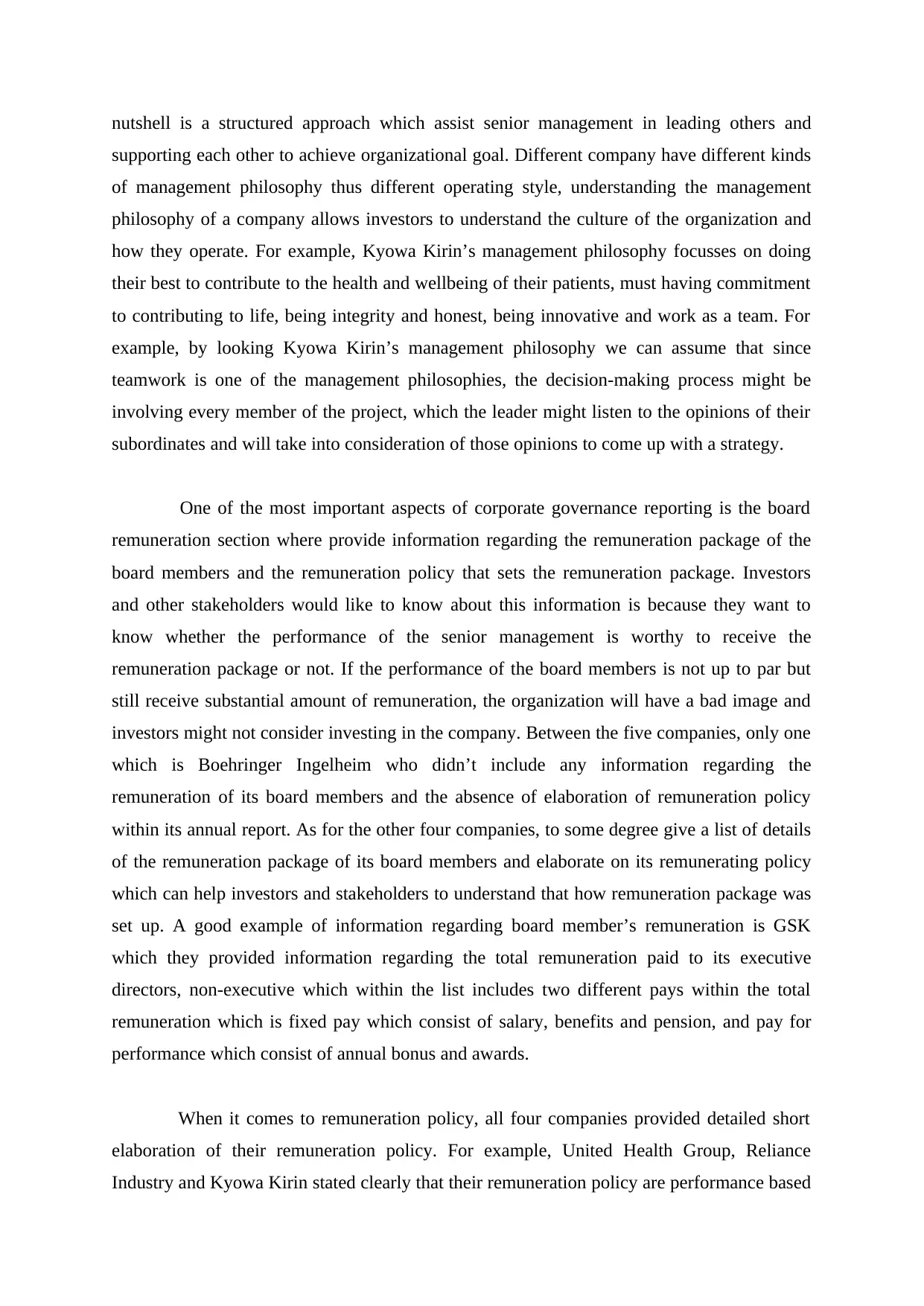
nutshell is a structured approach which assist senior management in leading others and
supporting each other to achieve organizational goal. Different company have different kinds
of management philosophy thus different operating style, understanding the management
philosophy of a company allows investors to understand the culture of the organization and
how they operate. For example, Kyowa Kirin’s management philosophy focusses on doing
their best to contribute to the health and wellbeing of their patients, must having commitment
to contributing to life, being integrity and honest, being innovative and work as a team. For
example, by looking Kyowa Kirin’s management philosophy we can assume that since
teamwork is one of the management philosophies, the decision-making process might be
involving every member of the project, which the leader might listen to the opinions of their
subordinates and will take into consideration of those opinions to come up with a strategy.
One of the most important aspects of corporate governance reporting is the board
remuneration section where provide information regarding the remuneration package of the
board members and the remuneration policy that sets the remuneration package. Investors
and other stakeholders would like to know about this information is because they want to
know whether the performance of the senior management is worthy to receive the
remuneration package or not. If the performance of the board members is not up to par but
still receive substantial amount of remuneration, the organization will have a bad image and
investors might not consider investing in the company. Between the five companies, only one
which is Boehringer Ingelheim who didn’t include any information regarding the
remuneration of its board members and the absence of elaboration of remuneration policy
within its annual report. As for the other four companies, to some degree give a list of details
of the remuneration package of its board members and elaborate on its remunerating policy
which can help investors and stakeholders to understand that how remuneration package was
set up. A good example of information regarding board member’s remuneration is GSK
which they provided information regarding the total remuneration paid to its executive
directors, non-executive which within the list includes two different pays within the total
remuneration which is fixed pay which consist of salary, benefits and pension, and pay for
performance which consist of annual bonus and awards.
When it comes to remuneration policy, all four companies provided detailed short
elaboration of their remuneration policy. For example, United Health Group, Reliance
Industry and Kyowa Kirin stated clearly that their remuneration policy are performance based
supporting each other to achieve organizational goal. Different company have different kinds
of management philosophy thus different operating style, understanding the management
philosophy of a company allows investors to understand the culture of the organization and
how they operate. For example, Kyowa Kirin’s management philosophy focusses on doing
their best to contribute to the health and wellbeing of their patients, must having commitment
to contributing to life, being integrity and honest, being innovative and work as a team. For
example, by looking Kyowa Kirin’s management philosophy we can assume that since
teamwork is one of the management philosophies, the decision-making process might be
involving every member of the project, which the leader might listen to the opinions of their
subordinates and will take into consideration of those opinions to come up with a strategy.
One of the most important aspects of corporate governance reporting is the board
remuneration section where provide information regarding the remuneration package of the
board members and the remuneration policy that sets the remuneration package. Investors
and other stakeholders would like to know about this information is because they want to
know whether the performance of the senior management is worthy to receive the
remuneration package or not. If the performance of the board members is not up to par but
still receive substantial amount of remuneration, the organization will have a bad image and
investors might not consider investing in the company. Between the five companies, only one
which is Boehringer Ingelheim who didn’t include any information regarding the
remuneration of its board members and the absence of elaboration of remuneration policy
within its annual report. As for the other four companies, to some degree give a list of details
of the remuneration package of its board members and elaborate on its remunerating policy
which can help investors and stakeholders to understand that how remuneration package was
set up. A good example of information regarding board member’s remuneration is GSK
which they provided information regarding the total remuneration paid to its executive
directors, non-executive which within the list includes two different pays within the total
remuneration which is fixed pay which consist of salary, benefits and pension, and pay for
performance which consist of annual bonus and awards.
When it comes to remuneration policy, all four companies provided detailed short
elaboration of their remuneration policy. For example, United Health Group, Reliance
Industry and Kyowa Kirin stated clearly that their remuneration policy are performance based
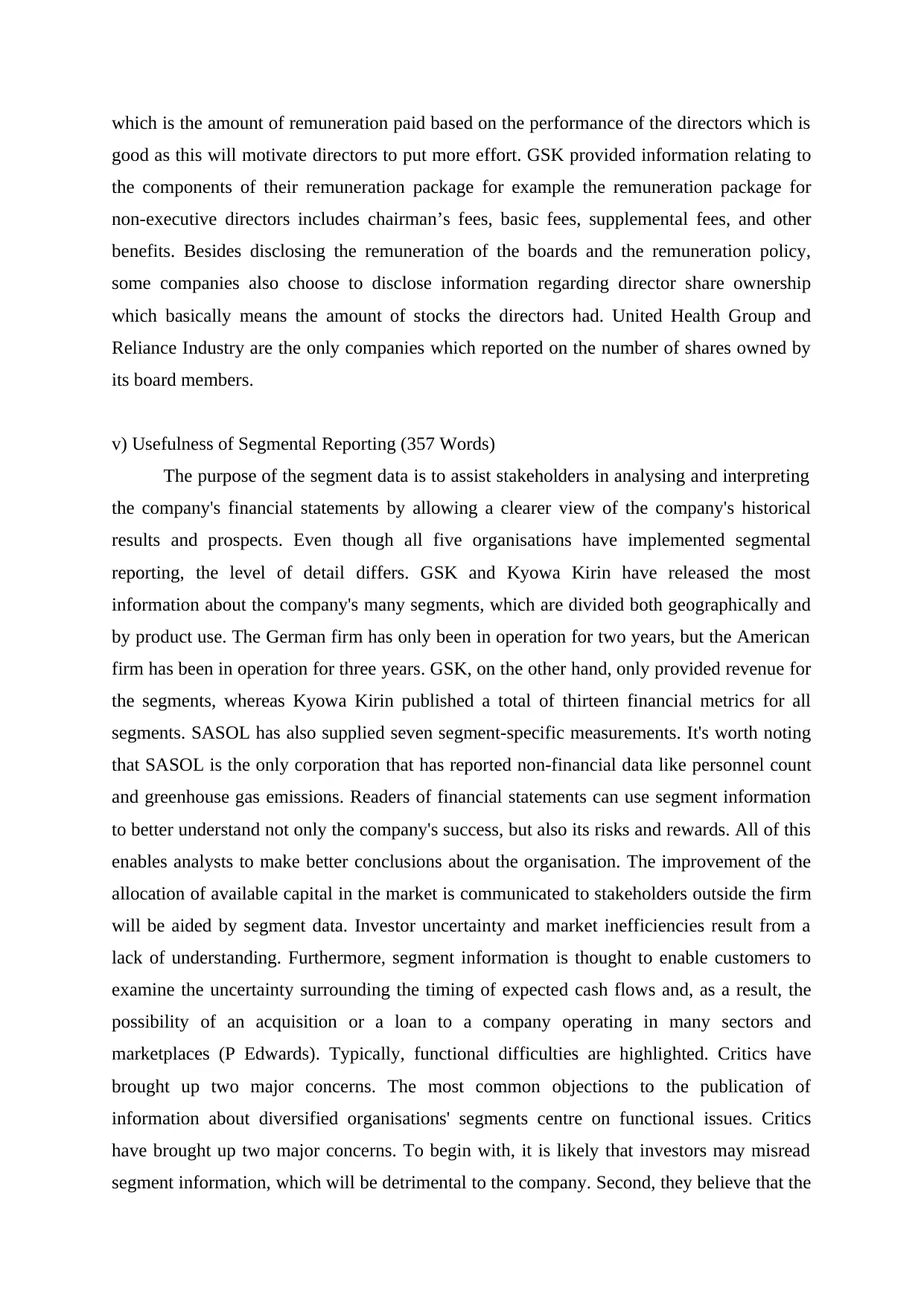
which is the amount of remuneration paid based on the performance of the directors which is
good as this will motivate directors to put more effort. GSK provided information relating to
the components of their remuneration package for example the remuneration package for
non-executive directors includes chairman’s fees, basic fees, supplemental fees, and other
benefits. Besides disclosing the remuneration of the boards and the remuneration policy,
some companies also choose to disclose information regarding director share ownership
which basically means the amount of stocks the directors had. United Health Group and
Reliance Industry are the only companies which reported on the number of shares owned by
its board members.
v) Usefulness of Segmental Reporting (357 Words)
The purpose of the segment data is to assist stakeholders in analysing and interpreting
the company's financial statements by allowing a clearer view of the company's historical
results and prospects. Even though all five organisations have implemented segmental
reporting, the level of detail differs. GSK and Kyowa Kirin have released the most
information about the company's many segments, which are divided both geographically and
by product use. The German firm has only been in operation for two years, but the American
firm has been in operation for three years. GSK, on the other hand, only provided revenue for
the segments, whereas Kyowa Kirin published a total of thirteen financial metrics for all
segments. SASOL has also supplied seven segment-specific measurements. It's worth noting
that SASOL is the only corporation that has reported non-financial data like personnel count
and greenhouse gas emissions. Readers of financial statements can use segment information
to better understand not only the company's success, but also its risks and rewards. All of this
enables analysts to make better conclusions about the organisation. The improvement of the
allocation of available capital in the market is communicated to stakeholders outside the firm
will be aided by segment data. Investor uncertainty and market inefficiencies result from a
lack of understanding. Furthermore, segment information is thought to enable customers to
examine the uncertainty surrounding the timing of expected cash flows and, as a result, the
possibility of an acquisition or a loan to a company operating in many sectors and
marketplaces (P Edwards). Typically, functional difficulties are highlighted. Critics have
brought up two major concerns. The most common objections to the publication of
information about diversified organisations' segments centre on functional issues. Critics
have brought up two major concerns. To begin with, it is likely that investors may misread
segment information, which will be detrimental to the company. Second, they believe that the
good as this will motivate directors to put more effort. GSK provided information relating to
the components of their remuneration package for example the remuneration package for
non-executive directors includes chairman’s fees, basic fees, supplemental fees, and other
benefits. Besides disclosing the remuneration of the boards and the remuneration policy,
some companies also choose to disclose information regarding director share ownership
which basically means the amount of stocks the directors had. United Health Group and
Reliance Industry are the only companies which reported on the number of shares owned by
its board members.
v) Usefulness of Segmental Reporting (357 Words)
The purpose of the segment data is to assist stakeholders in analysing and interpreting
the company's financial statements by allowing a clearer view of the company's historical
results and prospects. Even though all five organisations have implemented segmental
reporting, the level of detail differs. GSK and Kyowa Kirin have released the most
information about the company's many segments, which are divided both geographically and
by product use. The German firm has only been in operation for two years, but the American
firm has been in operation for three years. GSK, on the other hand, only provided revenue for
the segments, whereas Kyowa Kirin published a total of thirteen financial metrics for all
segments. SASOL has also supplied seven segment-specific measurements. It's worth noting
that SASOL is the only corporation that has reported non-financial data like personnel count
and greenhouse gas emissions. Readers of financial statements can use segment information
to better understand not only the company's success, but also its risks and rewards. All of this
enables analysts to make better conclusions about the organisation. The improvement of the
allocation of available capital in the market is communicated to stakeholders outside the firm
will be aided by segment data. Investor uncertainty and market inefficiencies result from a
lack of understanding. Furthermore, segment information is thought to enable customers to
examine the uncertainty surrounding the timing of expected cash flows and, as a result, the
possibility of an acquisition or a loan to a company operating in many sectors and
marketplaces (P Edwards). Typically, functional difficulties are highlighted. Critics have
brought up two major concerns. The most common objections to the publication of
information about diversified organisations' segments centre on functional issues. Critics
have brought up two major concerns. To begin with, it is likely that investors may misread
segment information, which will be detrimental to the company. Second, they believe that the
⊘ This is a preview!⊘
Do you want full access?
Subscribe today to unlock all pages.

Trusted by 1+ million students worldwide
1 out of 38
Your All-in-One AI-Powered Toolkit for Academic Success.
+13062052269
info@desklib.com
Available 24*7 on WhatsApp / Email
![[object Object]](/_next/static/media/star-bottom.7253800d.svg)
Unlock your academic potential
Copyright © 2020–2025 A2Z Services. All Rights Reserved. Developed and managed by ZUCOL.


